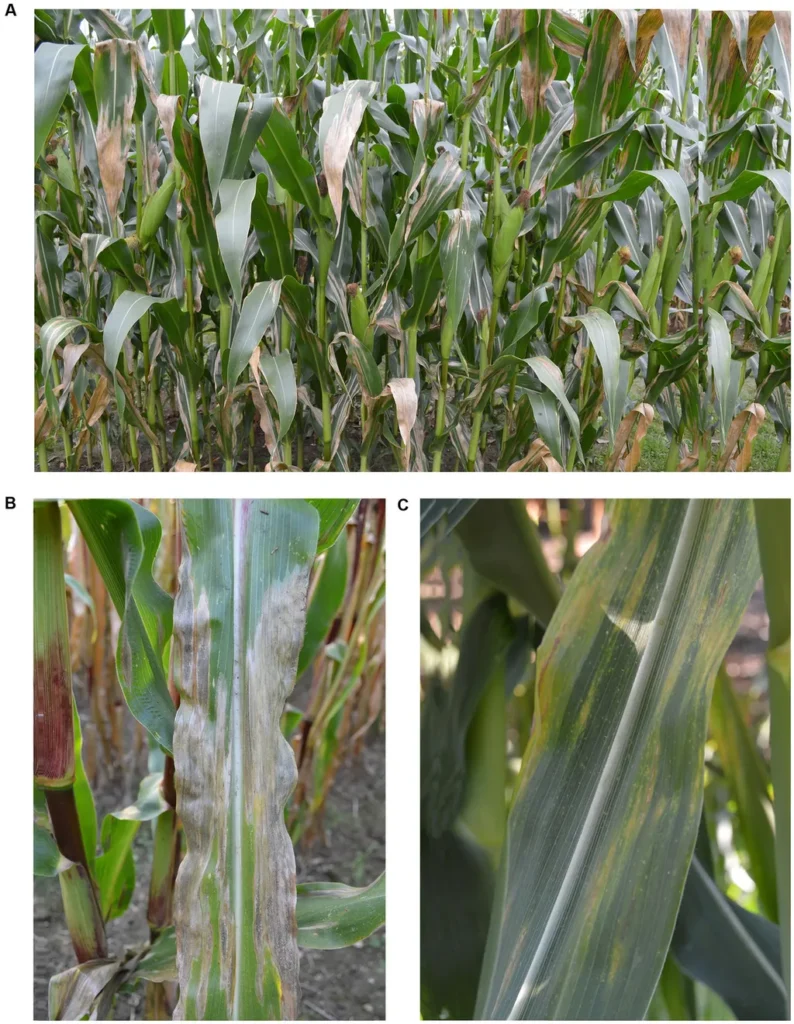In the heart of India, a team of researchers led by Dr. Bhupender Kumar at the ICAR-Indian Institute of Maize Research in Ludhiana, Punjab, has made a significant breakthrough in the fight against turcicum leaf blight (TLB), a devastating fungal disease that threatens maize crops worldwide. Their work, recently published in the *Journal of Agriculture and Food Research* (translated as “Journal of Agricultural and Food Research”), offers promising insights for maize breeders and farmers alike.
Maize, a staple crop for millions, faces numerous challenges, and TLB is one of the most formidable. Caused by the fungus *Setosphaeria turcica*, this disease can lead to substantial yield losses, impacting food security and economic stability. Dr. Kumar and his team set out to identify resistant maize lines and the genetic basis of this resistance, using advanced genomic techniques.
The team screened a diverse panel of 384 maize inbred lines across four hot-spot locations in India—Bajaura, Mandya, Dharwad, and Srinagar—over five years, from 2018 to 2022. They employed genome-wide association mapping (GWAS) to pinpoint key genomic regions and candidate genes (CGs) associated with TLB resistance. “Our goal was to identify stable genotypes and understand the genetic architecture of resistance to TLB,” Dr. Kumar explained.
Their efforts paid off. The researchers identified several stable genotypes that showed consistent resistance to TLB, including CML 334 W, UMI 1200, and DML 112. These lines could serve as valuable donors in future breeding programs, offering a much-needed boost to maize production.
The study revealed 16 significant marker trait associations (MTAs) linked to TLB resistance, spread across all chromosomes except for chromosomes 1, 9, and 10. These MTAs explained 23–30% of the phenotypic variation, highlighting their importance in disease resistance. Notably, seven of these MTAs overlapped with previously reported associations, while nine were novel, offering fresh insights into the genetic basis of TLB resistance.
Dr. Kumar emphasized the practical implications of their findings: “The identified candidate genes and stable resistant lines provide a clear path forward for breeders. This research advances our understanding of TLB resistance and opens doors for modern genomic selection, molecular breeding, and even genome editing.”
The team identified 18 candidate genes and 5 orthologous genes (Ortho-CGs) in the genomic regions of the MTAs. These genes were primarily associated with cellular anatomical entities, binding functions, and cellular processes, all crucial for mounting a defensive response against the fungus.
Some of the identified candidate genes, such as Zm00001eb226290, Zm00001eb293670, and Zm00001eb293590, have been previously linked to TLB disease resistance in both maize and sorghum. This cross-species relevance underscores the broader implications of the research, potentially benefiting other crops as well.
The findings hold significant promise for the agricultural sector, particularly in regions where maize is a primary crop. By incorporating these resistant lines and genetic insights into breeding programs, farmers can cultivate more resilient maize varieties, reducing yield losses and enhancing food security.
Dr. Kumar’s team has provided a roadmap for future research and practical applications. Their work not only advances our understanding of TLB resistance but also paves the way for innovative breeding strategies. As the world grapples with the challenges of climate change and food security, such breakthroughs are more critical than ever.
In the words of Dr. Kumar, “This research offers clear translational value for maize breeding. The identified stable resistant lines are valuable donors for future breeding programs, and the genetic insights will guide modern breeding techniques to develop TLB-resistant maize varieties.”
With this groundbreaking research published in the *Journal of Agriculture and Food Research*, the stage is set for a new era in maize breeding, one that promises to bolster agricultural resilience and food security worldwide.

